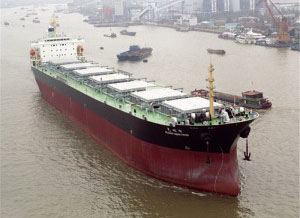BLOG
A Comprehensive History of Chinese Shipbuilding
China has a rich and extensive history in shipbuilding, stretching back thousands of years. This history is a testament to the country’s maritime ingenuity, innovation, and strategic importance in global trade. Chinese shipbuilding has evolved significantly over the centuries, reflecting the nation’s technological advancements and its pivotal role in maritime navigation and trade.
Ancient Chinese Shipbuilding

Early Beginnings
Chinese shipbuilding dates back to ancient times, with some of the earliest references found in texts from the Zhou Dynasty (1046–256 BCE). The Chinese initially built simple rafts and canoes from bamboo and wood. Over time, they began constructing more sophisticated vessels using advanced woodworking techniques.
The Junk: An Iconic Chinese Ship
One of the most renowned types of ships developed by the Chinese is the junk. Emerging around the Han Dynasty (206 BCE–220 CE), junks were versatile and robust vessels used for both inland and oceanic voyages. Their unique design featured multiple masts, fully battened sails, and watertight compartments, innovations that greatly influenced global shipbuilding.
Key Features of Junks:
- Watertight Bulkheads: These provided buoyancy and increased the ship’s resilience to damage.
- Fully Battened Sails: These sails improved maneuverability and stability in harsh weather conditions.
- Sternpost Rudder: A major innovation that enhanced steering control, later adopted by European shipbuilders.
The Maritime Silk Road
During the Tang (618–907 CE) and Song (960–1279 CE) Dynasties, Chinese shipbuilders began constructing larger, more seaworthy vessels to facilitate trade along the Maritime Silk Road. This ancient trade route connected China with Southeast Asia, the Indian subcontinent, the Arabian Peninsula, and East Africa.
The Golden Age of Chinese Shipbuilding
The Yuan Dynasty
The Yuan Dynasty (1271–1368) marked a significant period in Chinese shipbuilding. Under the Mongol rule, China expanded its naval capabilities, constructing large fleets for exploration and military purposes.
The Ming Dynasty and Zheng He’s Voyages
The pinnacle of Chinese maritime prowess was during the Ming Dynasty (1368–1644) under the leadership of the explorer Zheng He. Between 1405 and 1433, Zheng He led seven major naval expeditions across the Indian Ocean, reaching as far as the East African coast.
Zheng He’s Treasure Ships:
- Size and Scale: Some of these ships were over 400 feet long, dwarfing contemporary European vessels.
- Technological Advancements: They featured advanced navigational tools, reinforced hulls, and impressive cargo capacities.
- Impact on Global Trade: Zheng He’s voyages established China as a dominant maritime power, fostering diplomatic and trade relationships across the Indian Ocean.
Modern Chinese Shipbuilding
The Qing Dynasty to the Republic of China
The decline of the Ming Dynasty saw a reduction in naval activities, but the Qing Dynasty (1644–1912) maintained a robust shipbuilding industry for domestic trade and defense. The introduction of Western shipbuilding techniques during the late Qing period and the Republic of China era (1912–1949) marked the beginning of modernization in Chinese shipbuilding.
The People’s Republic of China
Since the establishment of the People’s Republic of China in 1949, the Chinese shipbuilding industry has undergone significant transformation. The government’s focus on industrialization and modernization has propelled China to the forefront of global shipbuilding.
Key Developments:
- Technological Innovation: Adoption of modern shipbuilding techniques and technologies.
- Expansion of Shipyards: Establishment of large, state-of-the-art shipyards along the Chinese coast.
- Diversification: Production of a wide range of vessels, including bulk carriers, container ships, tankers, and specialized ships.
Peida Machinery Group Co., Ltd.

76000DWT bulk cargo ship
A notable example of modern Chinese shipbuilding prowess is Peida Machinery Group Co., Ltd. Located in the Yangtze River region, Peida Machinery is a comprehensive shipyard firm engaged in design, construction, and trade. The company produces a variety of ships, including bulk carriers, container ships, passenger ships, oil tankers, chemical ships, tugs, and fiberglass boats. Peida Machinery also deals in second-hand ships and has been approved by various Classification Societies, reflecting its commitment to meeting diverse client needs.
Services Offered by Peida Machinery Group Co., Ltd.:
- Design and Construction: Expertise in designing and building a wide range of ships.
- Bulk Shipping: Production of large vessels for transporting bulk goods.
- Container Ships: Construction of vessels for global container shipping.
- Passenger Ships: Building of safe and comfortable passenger vessels.
- Oil Tankers and Chemical Ships: Production of specialized ships for transporting oil and chemicals.
- Tugs and Engineering Ships: Creation of support vessels for various maritime operations.
- Second-Hand Ships: Trading in used ships, providing cost-effective solutions for clients.
The Future of Chinese Shipbuilding
Technological Advancements
China continues to invest heavily in research and development to maintain its competitive edge in shipbuilding. The focus is on integrating advanced technologies such as automation, artificial intelligence, and green energy solutions to enhance the efficiency, safety, and environmental sustainability of ships.
Global Influence
China’s shipbuilding industry is poised to play a significant role in the global maritime economy. With state-of-the-art shipyards, experienced workforce, and strong governmental support, China is set to continue its legacy as a leader in shipbuilding.
Conclusion
The history of Chinese shipbuilding is a remarkable journey of innovation, resilience, and strategic importance. From ancient junks navigating the Maritime Silk Road to modern mega-shipyards producing state-of-the-art vessels, China’s shipbuilding industry has continuously evolved to meet the changing demands of global trade and maritime exploration. Companies like Peida Machinery Group Co., Ltd. exemplify the modern capabilities of Chinese shipbuilding, offering a wide range of services to clients worldwide. As technology advances and global trade continues to grow, China’s shipbuilding industry is well-positioned to remain at the forefront of maritime innovation and excellence.
FAQs
1. What were the key innovations of ancient Chinese shipbuilding?
Ancient Chinese shipbuilding introduced several key innovations, including watertight bulkheads, fully battened sails, and the sternpost rudder. These advancements significantly improved the seaworthiness, maneuverability, and safety of ships.
2. How did Zheng He’s voyages impact global trade?
Zheng He’s voyages during the Ming Dynasty established China as a dominant maritime power. His expeditions fostered diplomatic and trade relationships across the Indian Ocean, significantly impacting global trade by promoting the exchange of goods, culture, and knowledge.
3. What types of ships does Peida Machinery Group Co., Ltd. produce?
Peida Machinery Group Co., Ltd. produces a wide variety of ships, including bulk carriers, container ships, passenger ships, oil tankers, chemical ships, tugs, fiberglass boats, and various engineering ships. The company also deals in second-hand ships, catering to diverse client needs.
China’s shipbuilding legacy is a testament to its maritime ingenuity and strategic importance in global trade. As the industry continues to evolve, it remains a critical player in the advancement of maritime technology and global commerce.
BLOG
News
Contact Us
Contact: Peida Machinery Group Co. ,Ltd.
E-mail: info@peidaship.com
Tel: 0086 0556 5248992
Phone: 008618855615637
Add: City Anqing, Anhui Province